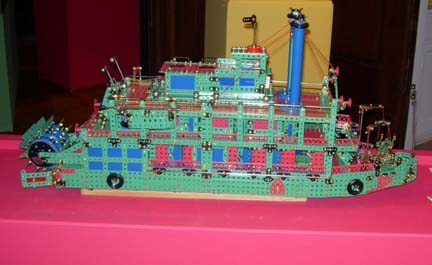The Paddlewheel Riverboat
As long as man has lived in America, rivers have served as transportation. Native Americans used canoes and log rafts; early white settlers added bateaus, flatboats and eventually keelboats. Movement downstream was easy; current carried passengers and cargo effortlessly. Going upstream created the challenge.By the beginning of the 19th century people began experiments with steam engines for marine power. In 1811, Robert Fulton and Nicholas Roosevelt built the first steam-powered boat, large enough for commercial use on the Ohio and Mississippi Rivers. No one knows what it looked like, for no drawings exist today. However, it proved that a steam-powered paddlewheel boat could be used on inland rivers.
Henry Shreve, a brilliant keelboat man, was the first to build truly a successful paddlewheel riverboat of sufficient size to be profitable, yet able to negotiate shallow rivers. His design became a standard for the Western rivers, and he is credited with launching the modern inland river transportation system.
Marklin No. 1082 Mississippi River Boat
 This operating model was built from a Marklin promotional assembly kit made only in 1992 in limited quantity. It is not a scale model, but represents a typical American stern wheel riverboat. Features include powered paddle wheel with prototypical connecting rod action, two working gangways, moveable rudders, 18 cabin doors that can be opened and closed and two life boats that can be lowered. The model contains some 5,409 parts (including nuts, bolts and washers). It is about 47" long and weighs 35 lbs.
This operating model was built from a Marklin promotional assembly kit made only in 1992 in limited quantity. It is not a scale model, but represents a typical American stern wheel riverboat. Features include powered paddle wheel with prototypical connecting rod action, two working gangways, moveable rudders, 18 cabin doors that can be opened and closed and two life boats that can be lowered. The model contains some 5,409 parts (including nuts, bolts and washers). It is about 47" long and weighs 35 lbs.
This type of boat has served as an important mode of transportation on the nation's rivers, including the Sacramento, up through World War II. Today, boats like this still ply the major rivers carrying tourists, but they are mostly Diesel powered and have bow thrusters and non-functional paddlewheels.
